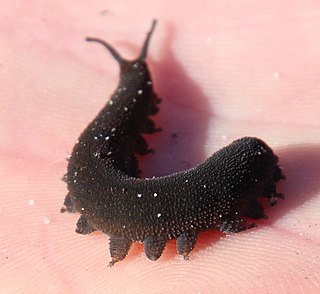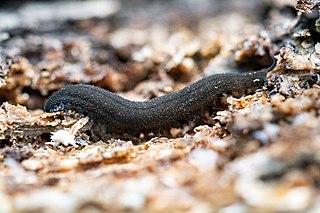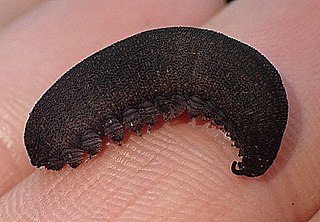
Peripatopsidae is one of the two living velvet worm families.
Metaperipatus is a genus of velvet worms in the family Peripatopsidae that contains two species found in Chile, including Metaperipatus inae. This genus was created by the American zoologist Austin Hobart Clark in 1913 to contain the type species, M. blainvillei. Authorities believe M. blainvillei is a species complex, however, and some consider M. blainvillei a nomen dubium.
Paraperipatus is a genus of velvet worms in the family Peripatopsidae. The number of legs vary within species as well as among species in this genus and can range from as few as 21 pairs up to 27 pairs in males and 29 pairs in females. The maximum number of leg pairs recorded in this genus (29) is also the maximum number of leg pairs found in the family Peripatopsidae. This genus exhibits matrotrophic viviparity, that is, mothers in this genus retain eggs in their uteri and supply nourishment to their embryos, but without any placenta. Species in this genus are found in New Guinea and Maluku, Indonesia.
Opisthopatus cinctipes is a species of velvet worm in the Peripatopsidae family. This species has 16 pairs of legs, all with claws and all used for walking. The color of the dorsal surface varies from blue to olive green. Females range from 7 mm to 50 mm in length, whereas males range from 6 mm to 36 mm. Like other velvet worms in this genus, this species exhibits matrotrophic viviparity, that is, mothers in this genus retain eggs in their uteri and supply nourishment to their embryos, but without any placenta. The type locality is in South Africa.
Opisthopatus amatolensis is a species of velvet worm in the Peripatopsidae family. This species has 16 pairs of legs. The type locality is in South Africa. The validity of this species is uncertain: Although some authorities deem O. amatolensis to be invalid even as a subspecies of O. cinctipes, a similar species also found in South Africa, other authorities recognize O. amatolensis as a separate species, citing the significant distance between the type localities of these two species.
Opisthopatus laevis is a species of velvet worm in the Peripatopsidae family. This species has 16 pairs of legs. The type locality is in South Africa. The validity of this species is uncertain: Some authorities consider O. laevis invalid even as a subspecies of O. cinctipes, a similar species also found in South Africa, but other authorities recognize O. laevis as a separate species, citing the significant distance (570 km) between the type localities of these two species.
Opisthopatus natalensis is a species of velvet worm in the Peripatopsidae family. This species has 16 pairs of legs. The type locality is in South Africa. The validity of this species is uncertain: Although some authorities have deemed O. natalensis to be a subspecies of O. cinctipes, a similar species also found in South Africa, and others regard O. natalensis as invalid even as a subspecies, still other authorities recognize O. natalensis as a separate species, citing the significant distance between the type localities of these two species.
Paraperipatus papuensis is a species of velvet worm in the Peripatopsidae family. This species is a pale greenish blue. Females of this species may have as few as 21 pairs of legs or as many as 29 pairs, exhibiting the greatest intraspecific variation in leg number found in any peripatopsid species. Males of this species range from 21 to 27 leg pairs. The maximum number of leg pairs recorded in this species (29) is also the maximum number of leg pairs found in the family Peripatopsidae. Females range from 22 mm to 83 mm in length, whereas males range from 19 mm to 45 mm. The type locality is in Western New Guinea, Indonesia.
Peripatopsis balfouri is a species of velvet worm in the Peripatopsidae family. This species has 18 pairs of clawed legs. Also known as the blue velvet worm, this species ranges from 9 mm to 22 mm in length. The type locality is in South Africa.

Peripatopsis capensis is a species of velvet worm in the Peripatopsidae family. This species has 18 pairs of legs: 17 pregenital leg pairs with claws plus one strongly reduced last pair without claws or spinous pads. Females of this species range from 9 mm to 70 mm in length, whereas males range from 6 mm to 54 mm. The native range of this species is limited to the Cape Peninsula of South Africa.
Peripatopsis hamerae is a species of velvet worm in the family Peripatopsidae. This species is a clade in the P. moseleyi species complex. The original description of this species is based on one specimen of each sex, each measuring 22 mm in length with a black dorsal surface and creamy white ventral surface. The male of this species has 22 pairs of pregenital legs and one pair of genital legs; the female has 23 pairs of pregenital legs and one pair of genital legs. Also known as the Kamala velvet worm, this species is known only from Groot Bruintjieshoogte in South Africa.
Peripatopsis intermedia is a species of velvet worm in the Peripatopsidae family. This species is about 33 mm long and has 19 pairs of legs: 18 pregenital leg pairs plus a last pair of much reduced legs. The type locality is in South Africa. Although some authorities doubt the validity of this species and deem it to be a junior synonym of P. balfouri, others consider these two to be separate species, citing the distance between their type localities.
Peripatopsis janni is a species of velvet worm in the family Peripatopsidae. This species is a clade in the P. moseleyi species complex. The original description of this species is based on male specimens ranging from 15 mm to 30 mm in length. Live animals are dark green on the dorsal surface but greyish white on the ventral surface. The number of legs in males of this species varies from 21 pregenital pairs to 22 pregenital pairs. Also known as the Amathole velvet worm, this species is found in the Amathole mountains in South Africa.

Peripatopsis moseleyi is a species of velvet worm in the Peripatopsidae family. Males of this species have 20 to 24 pairs of legs with claws ; females have 19 to 23 pairs of legs with claws. Females range from 11 mm to 75 mm in length, whereas males range from 9 mm to 50 mm. The type locality is in South Africa.
Peripatopsis sedgwicki is a species of velvet worm in the Peripatopsidae family. Also known as the Tsitsikamma velvet worm, this species has a narrow geographic distribution in South Africa but is especially abundant in the indigenous forest of the Tsitsikamma mountains. Recent phylogenetic analysis suggests that Peripatopsis sedgwicki is a species complex that contains three clades, each with a distinct geographic distribution, including at least one clade that may represent a novel species.

Peripatopsis overbergiensis, the Overberg velvet worm, is a species of velvet worm in the Peripatopsidae family. This species usually has 19 pairs of legs: 18 pregenital leg pairs plus one last pair that is strongly reduced and without claws or spinous pads. Some individuals, however, have only 18 leg pairs. This species is limited to the Overberg region of South Africa.
Peripatopsis storchi is a species of velvet worm in the family Peripatopsidae. This species is a clade in the P. moseleyi species complex. The number of legs in this species ranges from 21 pregenital pairs to 23 pregenital pairs. Males of this species range from 12 mm to 22 mm in length, and females range from 22 mm to 36 mm in length, but live animals can stretch to 50 mm while walking. Also known as the Katberg velvet worm, this species is known only from the Katberg forest in South Africa.

Peripatopsis clavigera, the Knysna velvet worm, is a species of velvet worm in the Peripatopsidae family. This species has 16 pairs of legs and ranges from 4 mm to 17 mm in length. Peripatopsis clavigera is found in subtropical or tropical moist montane forests of the Diepwalle Nature Reserve in South Africa.
Peripatopsis leonina, the Lion's Hill velvet worm, is a species of velvet worm in the Peripatopsidae family. This species has 20 to 24 pairs of legs, usually 21 or 22 leg pairs, with the last pair of legs reduced. Females of this species range from 7 mm to 41 mm in length, whereas males range from 7 mm to 34 mm.
Opisthopatus herbertorum is a species of velvet worm in the Peripatopsidae family. The type locality is in South Africa. As originally described, this species is uniformly white with 17 pairs of legs. Subsequent phylogenetic results, however, cast doubt on this species delimitation based on morphology, indicating instead that O. herbertorum is a junior synonym of O. roseus.





